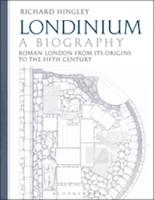
Bloomsbury Academic (2018) p/b 400pp £25.00 (ISBN 9781350047297)
H. is Professor of Roman Archaeology at the University of Durham. He is author of a number of books on Roman Britain, and now brings his knowledge and expertise to this biography of Roman London—an invaluable guide to all that is Roman in our capital.
The book is well illustrated with helpful chapter summaries, up to date bibliography and 78 pages of end notes. The eleven chapters range through Iron Age London, trade, Boudica’s assault and London’s recovery therefrom, ‘Hadrian’s Fires’, and the city’s heyday from AD 125-200. The appendix covers excavations carried out by Guildhall Museum and the Museum of London with site names and the main publication reporting the dig.
The author makes it clear that there are insurmountable challenges for any book such as this where most of the life story lies undiscovered, buried underground and built over by centuries of development. In addition, much that has been excavated sadly remains obscure and unpublished but, despite these obstacles, the author skilfully and clearly sets out his evidence—there is, of course, a huge amount that has been revealed and more is being unearthed all the time—to adumbrate the life of London, albeit an unavoidably restricted one.
The author, then, succeeds in his aim ‘to provide a synthesis of some of the most important information for Londinium and to present new perspectives consciously chosen to stimulate debate’. Particularly valuable is the author’s ability to cross traditional (and restricting) boundaries and explore the archaeology in terms of its social, commercial, political and religious significance, thus allowing the reader to engage with Roman London as a real place with significance to and consequences for Britannia and the wider empire.
The usual controversies are dealt with head on in the light of finds, or the lack of them: for example, the exact status and role of Londinium in the great imperial scheme of things, and whether a pre-Roman oppidum existed or not. The author, who does not discount the possibility, interestingly argues that ‘the landscapes and waterscapes of this area … had particular significance in pre-Roman times’ and ‘challenges the division that is drawn between ritual and mundane activities in past accounts of Londinium’s origins’, concluding that ‘the ritual and religious importance of the riverside influenced the urban development, creating a religious as much as a political and economic foundation’.
Yet more revelatory is the interesting possibility that the relatively few artefacts to be found in the charred layers that represent Boudica’s sacking of the settlement quite possibly suggest that the beleaguered Londoners, unlike the inhabitants of Camulodunum, suffered some serious looting, or had the time to escape with cartloads of their possessions.
London then, as now, was a cosmopolitan place, and it is the author’s acknowledgement and treatment of this throughout that sets it apart from decidedly more arid accounts that have been published; indeed, it is the people featured here that makes the book a true biography: no place really exists without its people. People flocked to Londonium from other parts of Britannia and from all regions of the empire and, as the author says, our knowledge of these immigrants is enhanced considerably by stable isotope analysis of teeth from burials revealing mortality data, life style and social status. Grave goods too can tell us a lot about personal religion, approximate date of death and social status. They tell us too about imports from far flung Roman lands, popular fashion, lifestyle, commerce and mundane possessions which help on the journey across the Lethe. Isotope analysis reveals fascinating information relating to gender, hair and eye colour, about origins and ancestry going back generations
Personally, I would have liked more on the contribution that the fascinating four hundred wooden tables from excavations at the Bloomberg site (2010-2013) make to this life story—the earliest records of Roman London, dating from AD 50-80— if only because they illustrate the beating heart of the place, making it personal and adding a very human element with its real people and their real issues. They make Londinium spring to life providing, I shudder to admit, a Roman equivalent, in some ways, to the ubiquitous tweet and blog of today.
All in all an essential book for anyone studying, researching or just enjoying Roman Britain, English and Roman history, Roman archaeology or urban studies.
Paul Chrystal
His The Romans in the North of England is due out in May.
